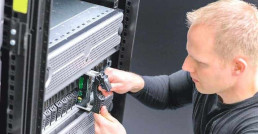Finding the right data center can be one of the best investments your organization ever makes.
Take the time to make the right choice for your business’ unique needs, and the returns will be immediate.
You’ll find this easy to do once you appreciate what a colocation data center is and which services matter for your company.
What Is Colocation?
Colocation is a popular alternative to traditional hosting.
With a traditional hosting setup, the service provider owns just about every component required to support your applications. This includes the software, hardware, and any other necessary elements of the infrastructure.
Conversely, colocation server hosting offers its clients with the physical structure these companies need for their hosting solutions.
The name “colocation” refers to the fact that many companies’ servers are “co-located” in the same building.
This is also referred to as a “multitenant” solution.
Each client is responsible for providing dedicated servers, routers, and any other hardware. Often, the colocation server provider will take a “hands-off” approach. This means the client’s employees need to physically travel to the data center if server maintenance or repairs are required.
This isn’t always the case, though. As we’ll cover in more detail below, many data centers offer many managed services.

What Is a Colocation Data Center?
A colocation data center is the facility that houses servers and other hardware on behalf of their clients. Inside data centers, racks of servers store data for the company’s clients.
One way to better comprehend onsite hosting and data centers is as two different types of homes.
Onsite hosting is like a house. You own everything to do with that property, and you’re responsible for its “operation” and maintenance costs.
A colocation facility is more like an apartment. You still have to pay certain fees. You still need to pay for most of what goes into an apartment, too. However, the owner is responsible for maintaining the property itself. This includes the physical structure that protects your investment.
Both have their advantages. Data center facilities are growing in popularity in the United States and Worldwide.
Some of the reasons for this are:
- Lower operating costs – For the vast majority of companies, it makes much more financial sense to outsource hosting. The costs of maintaining everything from servers to the power feeds just aren’t realistic. The same goes for the budget it would take for the space required. Then there’s the overhead related to security. Besides, not only do service providers keep these costs down, they usually do a better job, too. When you consider the decreased chance of downtime, savings go up even more.
- The need for fewer IT staff members – Another cost you’ll need to consider with onsite hosting is the need for a large IT team. After all, if anything happens to your servers, your company will be in big trouble. Most data centers have experts on staff who can be leveraged during an emergency. Many also have managed services, so you can hire the daily IT help you need at a fraction of the cost.
- Unparalleled Reliability – Again, downtime is expensive. Companies that rely solely on onsite hosting are vulnerable to any number of events. Anything from an earthquake to a busted water main could take them offline. Data centers are designed with disaster recovery in mind. Most have multiple data center locations, including outside of the United States, too, ensuring redundancy.
- Predictable Costs – As long as you read the fine print (more on this below), colocation providers will make forecasting easy. You know precisely what you must spend every month to keep your company online – no surprises.
- Ease of Scalability – Colocation services are incredibly scalable. Pay for what you need, and don’t bother with what you don’t. As the related costs are predictable, it’s easy to decide how much scaling your company can afford to do, too. Once you’ve completed the data center migration process, scalability is relatively easy. This gives your company the ability to scale up or down as necessary whenever you want.

9 Tips For Picking the Best Colocation Data Center
Now, you’ve got a better comprehension of what colocation solutions are and why they’re so popular – you must be excited to choose one.
Before you do, though, be sure to read through the following tips to ensure best results.
1. Be Clear About Your Company’s Unique Goals
No two companies are the same.
Therefore, even when two companies want the same thing – like colocation services – they may still have different needs.
That’s why it’s important to go over your company’s goals and objectives before considering colocation server hosting.
Otherwise, it will be all too easy to spend more than you need to, including on services you’ll never even use. You may also neglect specific requirements, only to realize your mistake after you’ve signed a contract and gone through migration.
If your company has been hosting onsite up to this point, this shouldn’t be too difficult to do. Look at what’s working and plan to scale up if necessary. Then, look at what services you need, and find colocation providers that can offer them.
If your company is brand new, this will be a little more difficult. Consider hiring a consultant or speaking to those at various data center facilities to realize what you need.
Either way, you may also need a facility that offers managed services. That would allow you to outsource many essential tasks to the experts at these facilities.
2. Ensure Data Center Infrastructure Supports Your Assets
On the other hand, there’s one advantage to building your infrastructure from scratch. You will most likely be more open to the technology you’ll use. In turn, this means you can consider more colocation facilities.
For those of you who are set on certain types of hardware and software, you must keep this in mind. Presumably, you chose both because it supports your organization’s goals and objectives. Therefore, some data centers won’t be options.
You must also confirm that a facility can support your power-density needs. Many companies need upwards of 10 kW for each of their cabinets. Older ones may not be able to meet these requirements. Others will, yet doing so will come at an increased cost.
Choosing a data center that can’t provide customer support to necessary assets would be a costly mistake. When you speak to a provider, list what your needs are upfront. There’s no point in proceeding if a data center facility can’t meet this essential requirement.

3. Remember: Location, Location, Location
Many data centers with more than one location provide disaster recovery as a service.
However, you most likely want one of those locations to be nearby your business. This is wise even if you plan on using the colocation facility as a secondary site. That way, your IT staff will be able to access it with ease.
Unless you plan on outsourcing all of your needs with managed services, this is essential.
4. Don’t Take the Advantages for Granted
While the benefits as mentioned earlier are extremely advantageous, not every data center may offer them to the same degree.
For example, many data centers allow themselves a certain number of outages every year. Before going beyond that point, they’re within their contract even if your company suffers as a result.
There are ways around that problem. A simplified example would be a business continuity plan that involves another colocation provider outside of the United States. That way, if a disaster causes an outage here, your other colocation service should be safe.
Still, take the time to go through the data center colocation agreement fine print. If you have questions about anything, put them in writing and make sure you document the answers the same way.
5. Go Through the Colocation Costs Carefully
Similarly, you’ll only benefit from predictable costs if you go through them with a fine-tooth comb. For example, you may need to pay an initial fee to set up your data center space. Another may do the same, only amortize the cost over a certain number of months.
This can make comparisons between colocation facilities misleading if you’re not careful.
For most companies, the best way to look at costs is to project how much your need for hardware will grow in the coming years. The hardware you utilize will dictate the power, space, and connectivity you need, too.
All of these factors affect the price you’ll pay.
Consider any colocation services you may eventually need the same way. These will also affect your budget going forward.
Concerns about your colocation costs and pricing should be part of your search criteria. You don’t want to choose a colo data center facility only to find out they won’t adjust their contracts.

6. Find Out What Your Migration Timeline Will Be
Although this may not necessarily amount to a deal-breaker, you should ask about how long migration will take. That’s because one factor tends to catch companies off guard.
As soon as migration begins, most colocation providers can meet extremely tight deadlines. This includes for putting your service cabinets in place, energizing your power strips, and equipping your team with security clearances.
Usually, all of this can be achieved within a month – possibly sooner depending on your needs.
However, the activation of a carrier circuit can easily take much longer. Your timeline extends to at least 90 days before connectivity is achieved. Unfortunately, until you have carrier connectivity, your migration cannot be completed, and your organization will be without its servers.
Again, if you can plan for the timeline involved, you don’t need to disqualify datacenters with longer ones.
One way to do this is to have a provider guarantee a migration date in your contract. If they’re helping, have them define each step of the migration process, too, with a date for each. No matter what, you need them to do this for security clearance, over which they have complete control.
7. Look for Facilities with Carrier Neutrality
Many colocation centers are corporation-owned. This usually means they have a limited offering when it comes to network carriers that offer colocation services.
Give priority to carrier-neutral data center facilities. They can offer you a much larger variety of carriers and options for connectivity, and this will mean competitive pricing. You will also be able to leverage the design of a redundant vendor network.

8. Don’t Assume More Floor Space Is Better
There’s nothing wrong with a data center that has an impressive amount of floor space.
Just know that, in and of itself, that trait isn’t incredibly important. It shouldn’t be seen as much of an advantage on its own.
Preferably, you want to fit as much equipment as possible in as little space as you can. By doing so, you’ll enjoy much better operating costs.
9. Make Sure Your Investment Will Be Safe
We’ve already mentioned the importance of picking a colocation facility that will meet your organizations disaster-recovery needs. Otherwise, your company could be without its servers for a prolonged period of time. That would be a highly expensive problem.
You need to consider the security of a data center for the same reason. As a multi-tenant facility, people from other companies will have access to it, as well.
That’s why you want to choose a location with multiple levels of physical security. These should exist both inside and outside the building. If you deem it necessary, you can also ask about adding cameras to your data center space for extra security.
Taking Your Time Choosing a Data Center Colocation Provider
Choosing a data center is one of the most important decisions you’ll make for the future of your business. So, while you may be anxious to begin leveraging its benefits, don’t rush.
Review the nine tips outlined above and consider as many options as possible.
Only after you have found the perfect choice should you proceed. Then, it’s just a matter of time before the perfect data center helps your company reach new heights.